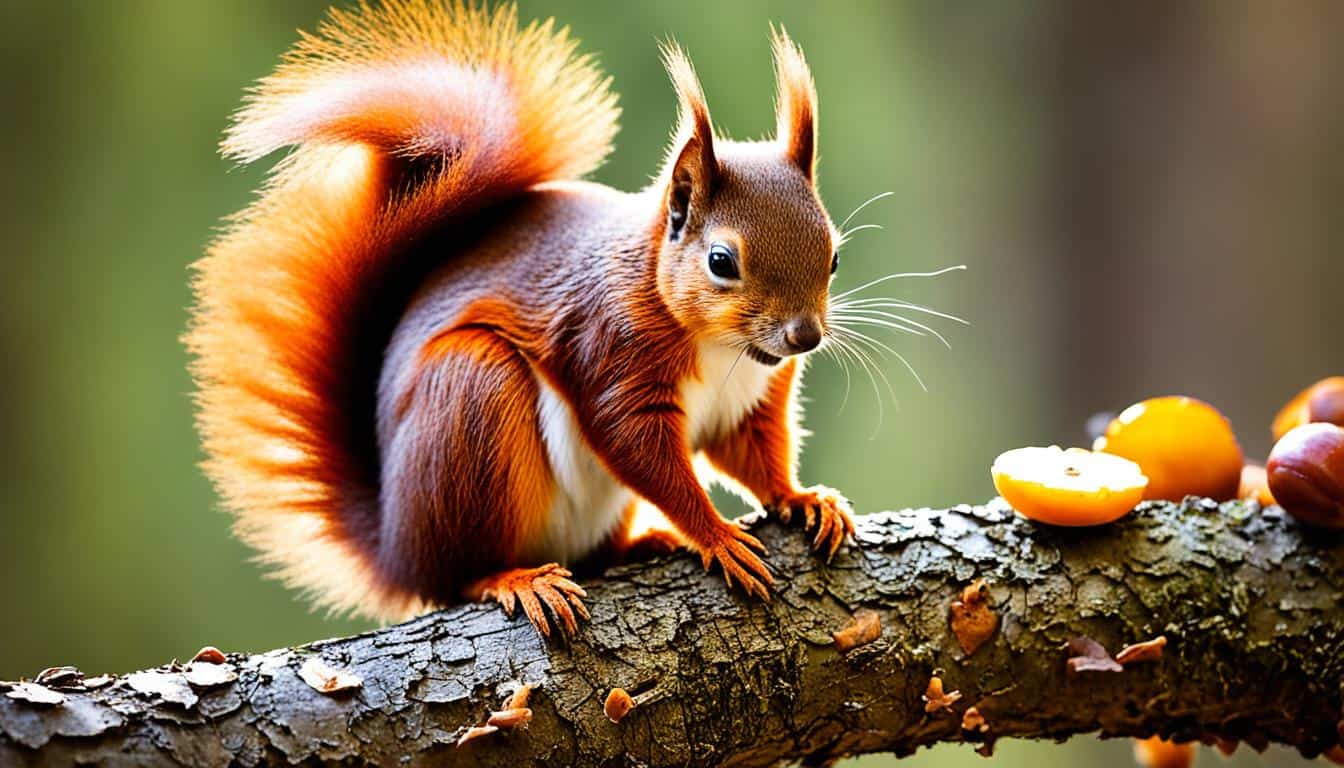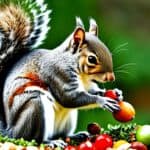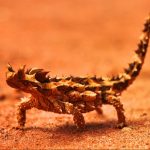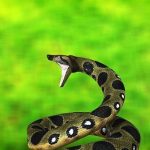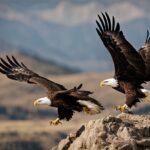Have you ever wondered about the red squirrel’s lively ways? These creatures are not picky. Their diet is quite the mix. They love seeds from trees like Scots pine, lodgepole pine, Norway spruce, and larch. These are common in the UK.
They also eat from hazel, oak, and beech trees. Their meals are not only plant-based, though. They enjoy flowers, buds, fruits, berries, and even fungi. Sometimes they eat bugs and bird eggs. They have a cunning move of drying mushrooms on tree branches.
This shows how clever and skilled they are at finding food. The red squirrels teach us a lot about the forest. They are important for the ecosystem.
Introduction to the Red Squirrel’s Diet
The red squirrel’s diet is broad and crucial to the forest’s health. Their omnivore diet lets them eat lots of different foods. Most of what they eat comes from trees, but this changes with the seasons.
Finding out what is the diet of a red squirrel means knowing they choose nuts wisely. They hide food to make sure they have plenty all year round. These smart creatures also like to eat dried mushrooms, which is pretty clever of them.
Red squirrels eat what they can find in each season. They don’t just stick to nuts and seeds. They eat flowers, buds, fruits, and more, including some animals like insects and bird eggs. This mix of food gives them a healthy diet all year.
When it comes to eating cones, red squirrels have a cool technique. They prepare for winter by drying mushrooms on tree branches. This shows how they have smart ways to survive. So, if you’re curious about what is the diet of a red squirrel, it’s clear they have a complex diet. It’s perfect for their forest homes.
Types of Food Red Squirrels Eat
Red squirrels eat a lot of different foods. They use the forest well, finding many types of food there. This includes some foods they find all year and others that are only around during certain seasons.
Nuts and Seeds
Red squirrels love nuts and seeds. They especially like the seeds from big trees like the Scots pine and Norway spruce. For nuts, they look for those from trees like the hazel, oak, and beech. These foods give the red squirrels fats and energy they need.
Fruits and Berries
In spring and summer, red squirrels get excited about fruits and berries. Things like apples and blackberries are their favorites. These foods have important vitamins and are a good source of water. They help the squirrels stay healthy and hydrated.
Animal Matter
Sometimes, red squirrels eat things that come from animals. This can be insects or even bird eggs. Such animal foods are great sources of proteins. They are super important when plant foods are hard to find. This shows how flexible red squirrels can be in what they eat, helping them survive tough times.
Below is a summary table highlighting some key components of red squirrel dietary preferences:
| Food Type | Examples | Nutritional Benefits |
|---|---|---|
| Nuts and Seeds | Scots pine seeds, hazelnuts | Essential fats, energy |
| Fruits and Berries | Apples, blackberries | Vitamins, hydration |
| Animal Matter | Insects, bird eggs | Proteins |
Seasonal Variations in Diet
Red squirrels adapt their diets each season, changing what they eat based on what’s available. This allows them to survive and thrive. Understanding their eating habits gives us a peek into their smart survival moves.
Spring Feeding Habits
In spring, red squirrels feast on tender shoots and flower buds. These foods are full of nutrients, helping squirrels bounce back from winter. It’s also the perfect time for them to bulk up for breeding. They roam more actively, looking for the freshest foods.
Autumn Foraging
As autumn arrives, red squirrels get serious about food collection. They stockpile nuts, fruits, and even mushrooms. What’s interesting is that these mushrooms get hung to dry. They work hard to pack their pantries full before winter sets in.
Winter Food Storage
In winter, their food hoards are a lifeline. Red squirrels depend on these hidden treasures to make it through the cold. Their careful storing of food shows us just how much they rely on this strategy to survive.
Foraging Habits of Red Squirrels
Red squirrels are not just grabbing food. They have a detailed way of finding and eating food. These agile creatures show unique foraging behavior. They leave behind signs like stripped cones and thrown scales. They have a good sense of where things are around them. This helps them find food fast in their home area.
They store food for winter in a special way. In the fall, they spend a lot of time gathering nuts, seeds, and other food. They bury it in many spots, creating a hidden food supply. This shows their intelligence and memory. It’s vital for them to survive when food is hard to find.
Winter makes them return to these hidden food spots a lot. They pick their stores to eat and stay nourished. This cycle of finding and storing food shows how well they adapt and face challenges. It helps them live well through changing seasons.
Now, let’s look at how their eating habits change with the seasons.
| Season | Foraging Activities |
|---|---|
| Spring | Gathering fresh shoots and flower buds. |
| Summer | Feeding on an abundance of seeds and nuts. |
| Autumn | Intensive foraging and caching for winter. |
| Winter | Retrieving food from stores to maintain energy. |
Red Squirrel Feeding Behavior in Urban Areas
In places where red squirrels live near us, they may eat food we give them. This can be good for their health and making babies. Yet, we need to be careful not to harm them by accident.
Impact of Human Feeding
Feeding red squirrels can help them get the right food. But, it’s important to watch and see what food they get. If we’re not careful, sick squirrels might spread diseases like squirrel pox. We should keep feeding spots tidy and use good food. This keeps them strong and well.
Precautions and Recommendations
When helping feed red squirrels, there are rules to follow to keep them safe:
- Maintain Cleanliness: Keep feeding areas very clean with the right cleaners to stop illness.
- Choose the Right Feed: Pick foods that are healthy for red squirrels and free of bad things.
- Smart Positioning: Put out food in safe spots, away from dangers like predators and cars.
Following these guidelines ensures we can support squirrel health. It also lets us enjoy helping them without causing harm.
Dietary Differences Between Red and Grey Squirrels
Red and grey squirrels have very different eating habits. What they eat affects how they survive and compete for food. Understanding these differences is key to recognizing their needs in the wild.
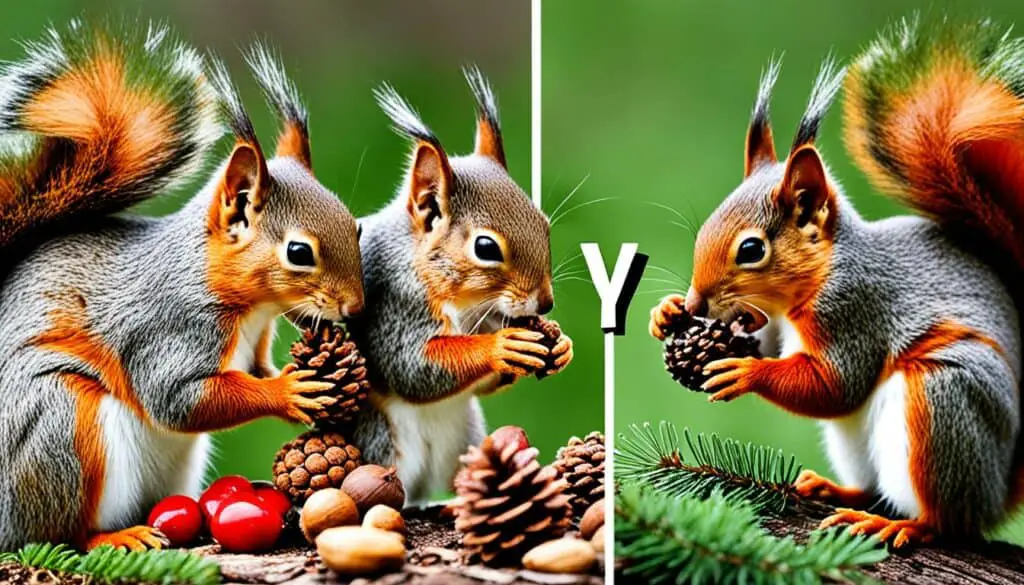
Red squirrels love eating certain tree seeds. They enjoy hazelnuts, elm seeds, and many tree cones. This choice of food helps them get all the important nutrients they need.
Grey squirrels have a wider taste. They can eat things like maize that red squirrels avoid. This ability means they can find food more easily, especially when there’s not much food to go around.
These eating habits are crucial when red and grey squirrels share the same area. Grey squirrels often have more food choices. This can make them the dominant squirrel, and push red squirrels to less preferred areas. Knowing how they eat helps with their protection and management.
| Aspect | Red Squirrels | Grey Squirrels |
|---|---|---|
| Primary Food Sources | Hazelnuts, Elm Seeds, Tree Cones | Maize, Various Nuts, Fruits |
| Dietary Specialization | Highly Specialized | Broad and Varied |
| Ability to Digest Different Foods | Limited | High |
| Implications for Survival | Dependent on Specific Trees | Flexible and Adaptive |
Nutritional Needs of Red Squirrels
Red squirrels have a diverse diet. They eat tree seeds, nuts, fungi, fruits, and sometimes animal proteins. This mix is crucial for their health and survival.
They mainly eat seeds from various trees. These seeds are full of key nutrients, giving them the energy they need. Fungi, fruits, and berries provide vitamins and micronutrients, boosting their vitality.
While not a big part of their diet, animal proteins are important. Insects and bird eggs can be on the menu when food from plants is hard to find. This shows their ability to eat a wide range of foods.
Young red squirrels can lack enough calcium. To fix this, they may eat bones or antlers as calcium sources. In some cases, they might need calcium supplements for good health.
Having a balanced, varied diet is crucial for red squirrels, especially where food is scarce. Good management and extra food can keep them healthy. This is important for meeting their dietary needs and avoiding health issues.
| Food Source | Nutritional Benefit |
|---|---|
| Tree Seeds | High energy content, essential oils |
| Nuts | Proteins, healthy fats |
| Fungi | Vitamins, minerals |
| Fruits & Berries | Vitamins, antioxidants |
| Animal Proteins | Amino acids for growth and repair |
| Bones/Antlers | Calcium source |
How to Support Red Squirrels in Your Area
Helping red squirrels in your area is very doable and makes a big difference. Start by creating feeding places designed just for them. Use hazelnuts and sunflower seeds, but stay away from maize. Maize attracts grey squirrels and makes food fights happen. Make sure their food is safe from other critters by putting it in special feeder boxes.
It’s also vital to provide them with water. Squirrels need to drink, especially when it’s dry out. Place a shallow dish of water near their food spots. This will help them stay hydrated. Think about planting trees like hazel, beech, and oak. These trees can make your area more like their natural home. It’s a good way to help them find natural food just like they would in the wild.
Getting involved in local conservation is another great step. You can donate or volunteer with groups that protect squirrel homes. Focus on supporting efforts that battle against grey squirrels. By doing this, you’re helping red squirrels stay safe and happy in their own spaces.
FAQ
What is the diet of a red squirrel?
Red squirrels love tree seeds, especially from conifers like Scots pine and larch. They also eat seeds from hazel, oak, and beech trees. Other foods in their diet include fruits, berries, flowers, and animal matter like insects and bird eggs.
What are the red squirrel’s eating habits?
Red squirrels are smart about their meals. They pick nuts with their paws and even dry mushrooms. They save food for the winter and have favorite items depending on the time of year.
What types of food do red squirrels eat?
Red squirrels enjoy many types of foods:
- Nuts and Seeds: They gather them from both coniferous and broadleaved trees.
- Fruits and Berries: These add variety and nutrition, especially in the right seasons.
- Animal Matter: They eat things like insects and bird eggs when they find them.
How does the red squirrel’s diet change with the seasons?
Red squirrels eat different foods throughout the year:
- Spring: They like fresh shoots and flower buds.
- Autumn: Nuts, fruits, and mushrooms, they keep some for winter.
- Winter: They rely on hidden food, like cones and nuts, they saved.
What are the foraging habits of red squirrels?
Red squirrels search high and low for food. They make marks, like with stripped cones, as they go. In winter, they’re especially good at finding stored food.
How does human feeding impact red squirrels in urban areas?
Giving red squirrels extra food in cities can help. But, it’s key to feed them right to not spread diseases, like squirrel pox. Clean areas and the right food choices are essential for their well-being.
What precautions should be taken when feeding red squirrels?
To feed red squirrels right, keep their feeding spots tidy. Use safe cleaning products and select the best foods. Place feeders to keep them safe and to avoid attracting predators. This helps prevent diseases from spreading.
What are the dietary differences between red and grey squirrels?
Red and grey squirrels have different favorite foods. Reds prefer tree seeds and nuts, while greys, like maize, eat a wider range. This affects how well they can find food in certain environments.
What are the nutritional needs of red squirrels?
Red squirrels need a mixed diet. This includes seeds, nuts, fruits, and sometimes animal proteins. Especially where they live among humans, ensuring variety and balancing their diet is important. Young squirrels may need extra calcium.
How can you support red squirrels in your area?
You can help red squirrels by offering good foods like hazelnuts and sunflower seeds at feeding stations. Also, provide water and plant food-friendly flora. Joining in on local conservation work is another big way to support them.

